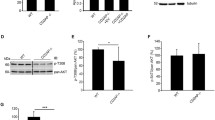Abstract
The purpose of our research is to elucidate whether oxLDL activates P2X7R in cultured human podocytes and if the activation of P2X7R leads to podocyte apoptosis. Additionally, we explore the underlying mechanism involved in podocyte apoptosis. Immortalized human podocytes were incubated with oxLDL (80 µg/ml), P2X7R antagonist A438079 (10 µM), or the compound of A438079 and oxLDL for 48 h, respectively. Cellular apoptosis and ROS were evaluated using flow cytometer. P2X7R, Bax, and Caspase-3 protein expression were detected by western blot and immunofluorescence analysis.The expression of P2X7R, ROS, Bax, and Caspase-3 in human podocytes incubated with oxLDL was significantly up-regulated and was found to have higher intracellular lipid accumulation and podocyte apoptosis compared with the NC group. However, co-administration with A438079, ROS, Bax, and Caspase-3 expression both significantly down-regulate as well as lower lipid accumulation and cellular apoptosis in the oxLDL-induced podocyte group. We revealed that P2X7R is involved in the regulation of oxLDL-treated podocytes. Additionally, we found that the anti-apoptotic effect of A438079 is correlated with ROS, Bax, and Caspase-3 expression down-regulated.






Similar content being viewed by others
References
Fogo AB (2011) The targeted podocyte. J Clin Invest 121:2142–2145
Mathieson PW (2009) Update on the podocyte. Curr Opin Nephrol Hypertens 18:206–211
Wickman C, Kramer H (2013) Obesity and kidney disease: potential mechanisms. Semin Nephrol 33:14–22
Wanner C, Greiber S, Kramer-Guth A, Heinloth A, Galle J (1997) Lipids and progression of renal disease: role of modifed low density lipoprotein and lipoprotein(a). Kidney Int Suppl 63:S102–S106
Lee HS, Song CY (2009) Oxidized low-density lipoprotein and oxidative stress in the development of glomerulosclerosis. Am J Nephrol 29:62–70
Galle J, Heermeier K, Wanner C (1999) Atherogenic lipoproteins, oxidative stress, and cell death. Kidney Int Suppl 71:S62–S65
Mulec H, Johnsen SA, Wiklund O, Bjorck S (1993) Cholesterol: a renal risk factor in diabetic nephropathy? Am J Kidney Dis 22:196–201
Peng K, Liu L, Wei D, Lv Y, Wang G, Xiong W, Wang X, Altaf A, Wang L, He D, Wang H, Qu P (2015) P2X7R is involved in the progression of atherosclerosis by promoting NLRP3 inflammasome activation. Int J Mol Med 35:1179–1188
Burnstock G, Knight GE (2018) The potential of P2X7 receptors as a therapeutic target, including inflammation and tumour progression. Purinergic Signal 14:1–18
Surprenant A, Rassendren F, Kawashima E, North RA, Buell G (1996) The cytolytic P2Z receptor for extracellular ATP identified as a P2X receptor (P2X7). Science 272:735–738
Di Virgilio F (1995) The P2Z purinoceptor: an intriguing role in immunity, inflammation and cell death. Immunol Today 16:524–528
Coutinho-Silva R, Persechini PM, Bisaggio RD, Perfettini JL, Neto AC, Kanellopoulos JM, Motta-Ly I, Dautry-Varsat A, Ojcius DM (1999) P2Z/P2X7 receptor-dependent apoptosis of dendritic cells. Am J Physiol 276:C1139–C1147
Harada H, Chan CM, Loesch A, Unwin R, Burnstock G (2000) Induction of proliferation and apoptotic cell death via P2Y and P2X receptors, respectively, in rat glomerular mesangial cells. Kidney Int 57:949–958
Cockcroft S, Gomperts BD (1979) ATP induced nucleotide permeability in rat mast cells. Nature 279:541–542
Virginio C, MacKenzie A, North RA, Surprenant A (1999) Kinetics of cell lysis, dye uptake and permeability changes in cells expressing the rat P2X7 receptor. J Physiol 519:335–346
Garg P, Holzman LB (2012) Podocytes: gaining a foothold. Exp Cell Res 318:955–963
Gutwein P, Abdel-Bakky MS, Schramme A, Doberstein K, Kämpfer-Kolb N, Amann K, Hauser IA, Obermüller N, Bartel C, Abdel-Aziz AA, El Sayed el SM, Pfeilschifter J (2009) CXCL16 is expressed in podocytes and acts as a scavenger receptor for oxidized low-density lipoprotein. Am J Pathol 174:2061–2072
Fernando RL, Varghese Z, Moorhead JF (1993) Oxidation of lowdensity lipoproteins by rat mesangial cells and the interaction of oxidized low-density lipoproteins with rat mesangial cells in vitro. Nephrol Dial Transplant 8:512–518
Beaucage KL, Xiao A, Pollmann SI, Grol MW, Beach RJ, Holdsworth DW, Sims SM, Darling MR, Dixon SJ (2014) Loss of P2X7 nucleotide receptor function leads to abnormal fat distribution in mice. Purinergic Signal 10:291–304
Wang L, Sun S, Zhou A, Yao X, Wang Y (2014) OxLDL-induced lipid accumulation in glomerular podocytes: role of IFN-γ, CXCL16, and ADAM10. Cell Biochem Biophys 70:529–538
Vonend O, Turner CM, Chan CM, Loesch A, Dell’Anna GC, Srai KS, Burnstock G, Unwin RJ (2004) Glomerular expression of the ATP-sensitive P2x7 receptor in diabetic and hypertensive rat models. Kidney Int 66:157–166
Menzies RI, Booth JWR, Mullins JJ, Bailey MA, Tam FWK, Norman JT, Unwin RJ (2017) Hyperglycemia-induced renal P2X7 receptor activation enhances diabetes-related injury. EBioMedicine 19:73–83
Li R, Zhang L, Shi W, Zhang B, Liang X, Liu S, Wang W (2013) NFAT2 mediates high glucose-induced glomerular podocyte apoptosis through increased Bax expression. Exp Cell Res 319:992–1000
Sha WG, Shen L, Zhou L, Xu DY, Lu GY (2015) Down-regulation of miR-186 contributes to podocytes apoptosis in membranous nephropathy. Biomed Pharmacother 75:179–184
Shi JX, Wang QJ, Li H, Huang Q (2016) Silencing of USP22 suppresses high glucose-induced apoptosis, ROS production and inflammation in podocytes. Mol BioSyst 12:1445–1456
Hua W, Huang HZ, Tan LT, Wan JM, Gui HB, Zhao L, Ruan XZ, Chen XM, Du XG (2015) CD36 mediated fatty acid-induced podocyte apoptosis via oxidative stress. PLoS ONE 10:e0127507
Toyonaga J, Tsuruya K, Ikeda H, Noguchi H, Yotsueda H, Fujisaki K, Hirakawa M, Taniguchi M, Masutani K, Iida M (2011) Spironola- ctone inhibits hyperglycemia-induced podocyte injury by attenuating ROS production. Nephrol Dial Transplant 26:2475–2484
Acknowledgements
This work is funded by the Natural Science Foundation of Shandong Province (ZR2015HM009) and Shandong Key R&D Program (2017 GSF218005).
Author information
Authors and Affiliations
Corresponding author
Ethics declarations
Conflict of interest
The authors declare that they have no conflict of interest.
Additional information
Publisher's Note
Springer Nature remains neutral with regard to jurisdictional claims in published maps and institutional affiliations.
Rights and permissions
About this article
Cite this article
Zhu, Y., Li, Q., Xun, W. et al. Blocking P2X7 receptor ameliorates oxidized LDL-mediated podocyte apoptosis. Mol Biol Rep 46, 3809–3816 (2019). https://doi.org/10.1007/s11033-019-04823-6
Received:
Accepted:
Published:
Issue Date:
DOI: https://doi.org/10.1007/s11033-019-04823-6




